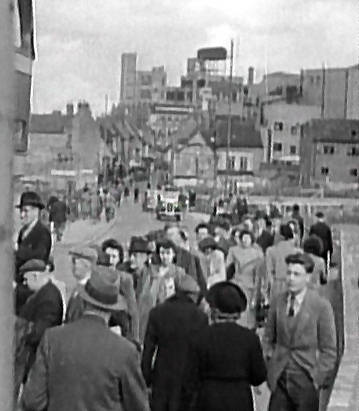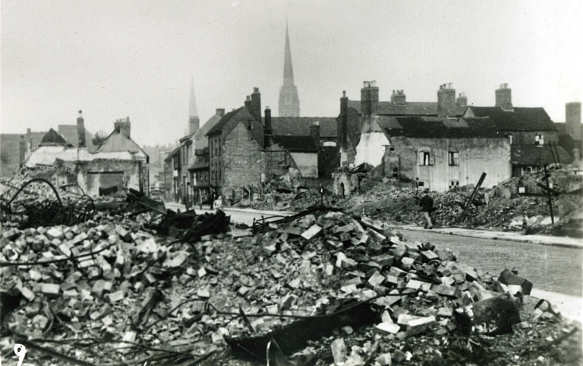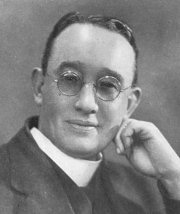|
Index...
|
 s the raid progressed, mixtures of high explosives, incendiaries, oil bombs and land-mines came down, and gradually our ancient city centre, the street plan of which had not significantly altered since medieval times, succumbed to the ferocity of the attack, the likes of which had never been seen in any town of our size. Below the ground, thousands of bewildered citizens sat tight in dozens of air-raid shelters and hundreds more small Anderson shelters. As some shelters became untenable through either nearby explosions or fires which turned them into large ovens, it was a common occurrence that night for streams of people to be led into another already crowded shelter by the amazing Air Raid Wardens who risked their lives constantly during the eleven hour onslaught. Most were saved by these structures, but few could withstand a direct hit, and by the end of the raid over five hundred people were left dead and over a thousand more injured.
s the raid progressed, mixtures of high explosives, incendiaries, oil bombs and land-mines came down, and gradually our ancient city centre, the street plan of which had not significantly altered since medieval times, succumbed to the ferocity of the attack, the likes of which had never been seen in any town of our size. Below the ground, thousands of bewildered citizens sat tight in dozens of air-raid shelters and hundreds more small Anderson shelters. As some shelters became untenable through either nearby explosions or fires which turned them into large ovens, it was a common occurrence that night for streams of people to be led into another already crowded shelter by the amazing Air Raid Wardens who risked their lives constantly during the eleven hour onslaught. Most were saved by these structures, but few could withstand a direct hit, and by the end of the raid over five hundred people were left dead and over a thousand more injured.

Although the Germans generally confined their bombing to a relatively small area in the centre of Coventry - roughly half a mile by three-quarters, centered around Broadgate - there were quite a few that were dropped outside this target area; one of the worst cases being a stick of six bombs falling by mistake in the centre of Leamington, sadly killing seven people. On a slightly lighter note, one of those same bombs caused a memorial statue to Queen Victoria to move one inch on its plinth!
 Just across the street from the Council House (near the end of the street in the above photo, and on the left) used to stand a part of old Coventry that was steeped in history.... the old Palace Yard.
Just across the street from the Council House (near the end of the street in the above photo, and on the left) used to stand a part of old Coventry that was steeped in history.... the old Palace Yard.
This photograph on the left shows the exact opposite viewpoint from the one above, and in the right-centre of the picture can be seen the cleared away space where Palace Yard once resided.
By the time this happier snapshot of Coventry life was recorded, the war was nearly over, and people are beginning to see their way towards 'normality' once again.
However, they had endured heart-breaking events that nobody should ever have to go through, and life could never be quite the same for those who had lost loved ones.
 enerally though, despite the Germans claiming to be targeting military objectives such as our factories, the bombing was quite indiscriminate, and in addition to the infamous destruction of our cathedral, the planes appeared to be regularly dropping bombs on or near the Coventry & Warwickshire hospital. It's possible that from above it could've been mistaken for a factory, but that would've been small comfort for the terrified patients, nurses and doctors inside, who performed virtually miraculous deeds in seemingly impossible circumstances. And not only Coventry based services - dozens of fire engines from surrounding areas, including Solihull, raced to Coventry to tackle blazes, but as water mains were eventually hit by explosives, their brave attempts were shattered.
enerally though, despite the Germans claiming to be targeting military objectives such as our factories, the bombing was quite indiscriminate, and in addition to the infamous destruction of our cathedral, the planes appeared to be regularly dropping bombs on or near the Coventry & Warwickshire hospital. It's possible that from above it could've been mistaken for a factory, but that would've been small comfort for the terrified patients, nurses and doctors inside, who performed virtually miraculous deeds in seemingly impossible circumstances. And not only Coventry based services - dozens of fire engines from surrounding areas, including Solihull, raced to Coventry to tackle blazes, but as water mains were eventually hit by explosives, their brave attempts were shattered.

All night long the seemingly never-ending attack continued. That night brought about many acts of heroism, but equally, many of indescribable terror. Not being directly hit by a bomb was no guarantee of staying alive, and some residents of a Coundon street paid the price of not recognising a strange object that dropped by parachute and blocked the roadway. It was, of course, one of the so called land mines, but not realising this, a group of brave people tried to push it out of the way to clear the way for an ambulance. The mine exploded, and of the poor souls around it, nothing remained. This type of incident also caused many problems later for the authorities, because the absence of identifiable corpses made it extremely difficult to work out how many had been killed, and who they were. This problem was exacerbated by the fact that many people left Coventry during these periods for the relative safety of the countryside, and many apparently 'missing' people had simply gone elsewhere.

By the time of this raid, a huge slice of Coventry's population had moved out of the city. Exact figures are not recorded, but estimates vary from 50,000 to 100,000 people, which equates to somewhere between a quarter and a half of the total population. One cannot blame these people for wanting to flee the city, but it did create certain problems, one being that fires in many house and small businesses were started by stray incendiary bombs, and unattended premises would soon become an inferno.

Reverend G. W. Clitheroe (left) of Holy Trinity Church was rather scathing about such activities, and reminded us in his book, "Coventry Under Fire", written shortly after the raids, that one or two vigilant people could easily deal with occasional incendiary devices, and very many fires could have been avoided if fewer people had fled Coventry during the attacks.
However, this was all too often not the case, and thousands of people wearily returned to the streets where they lived the next morning, to find that they no longer had an inhabitable home. Holy Trinity, meanwhile, still stood proud, in no small part due to the almost super-human efforts and diligence of Clitheroe and his small team, who had made sterling preparations before the raids by purchasing powerful hydrants and ladders, and placing these, plus buckets of sand and water, all around the nine roofs of the church. Clitheroe's fighting spirit embraced all that was best about British character. He even wished for an anti-aircraft gun on the church roof, so that he could fight back against the enemy, rather than simply defend his property.
The resolve of Coventry's bombarded citizens had never, however, been tested in such an extraordinary way, and nobody could begin to guess what sort of scene would be presented to them as they crawled out from their shelters the next morning.

Website by Rob Orland © 2002 to 2025